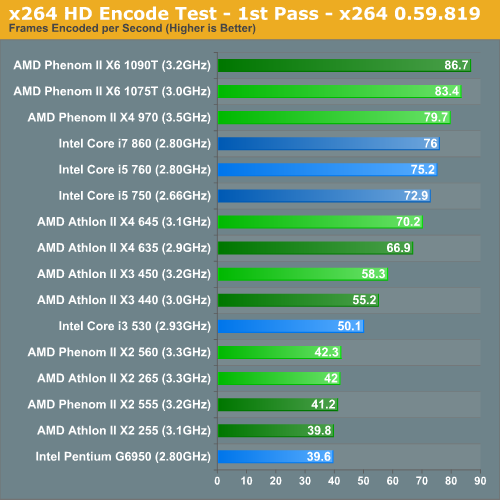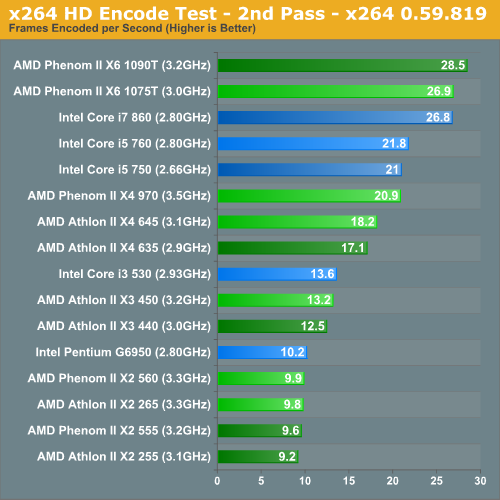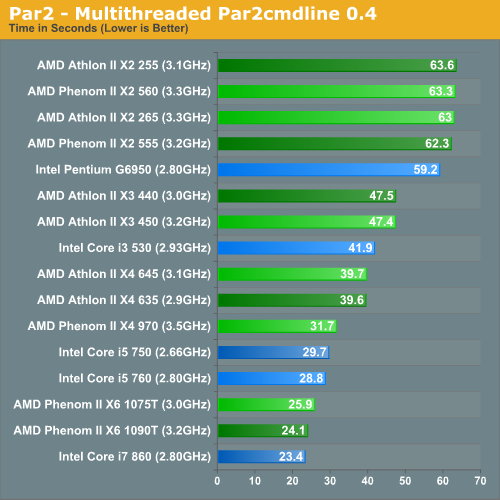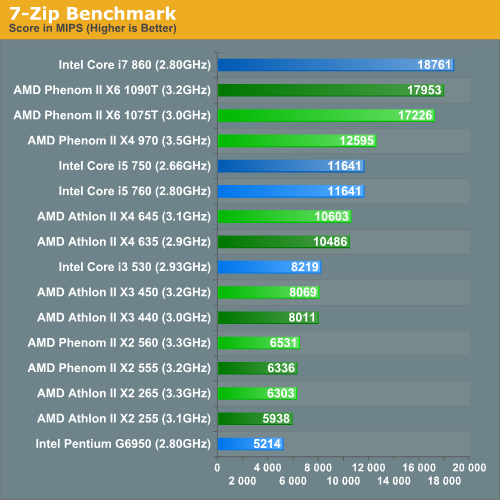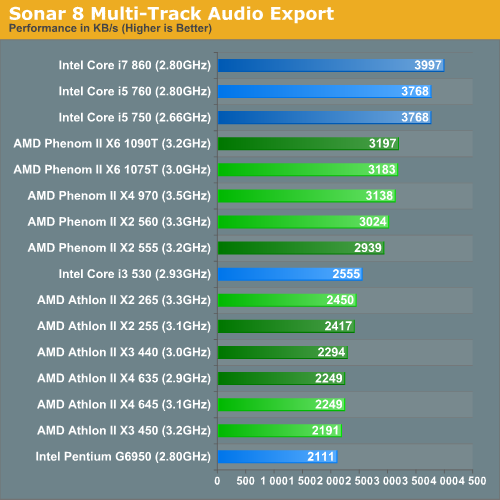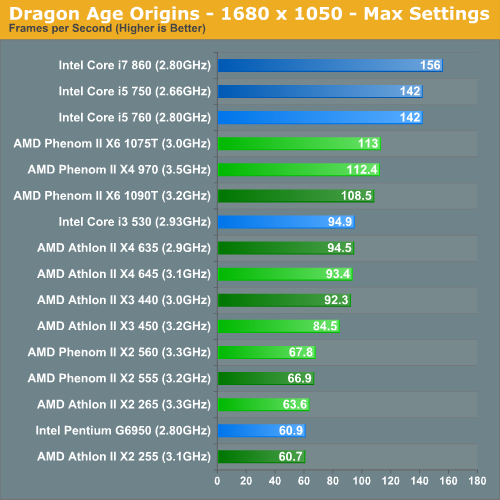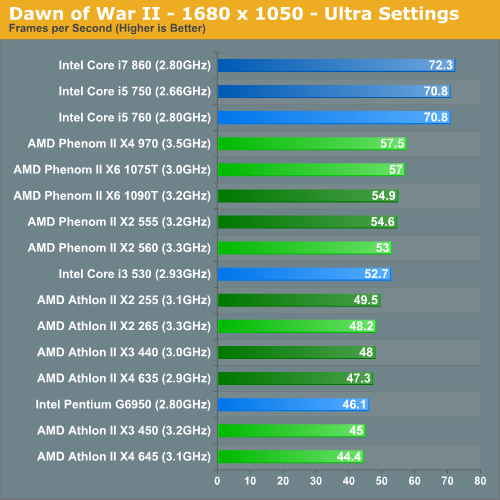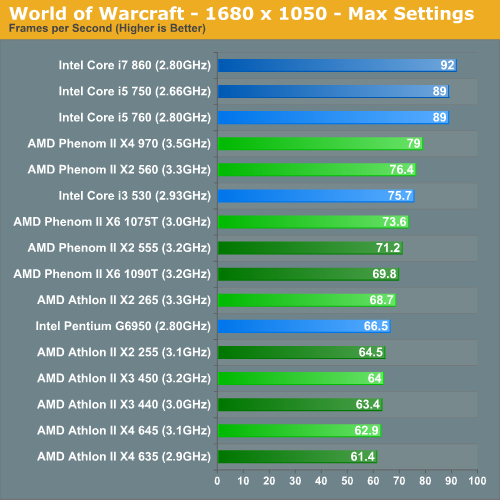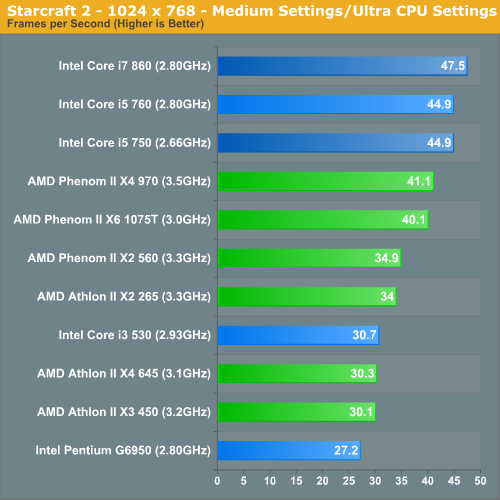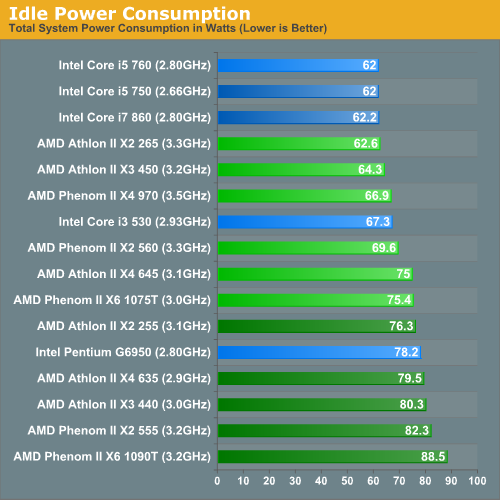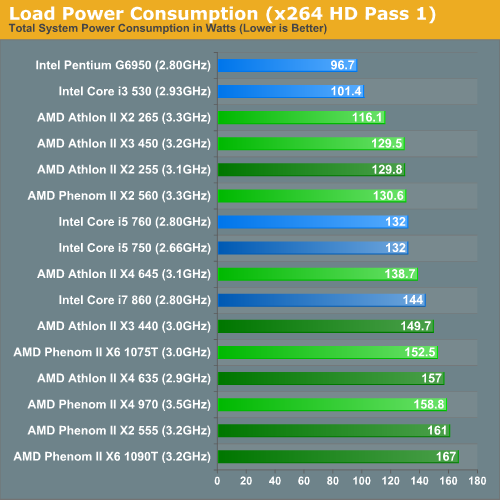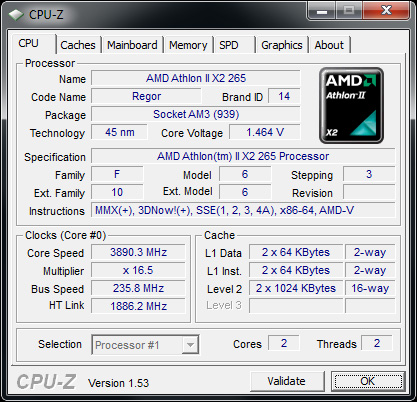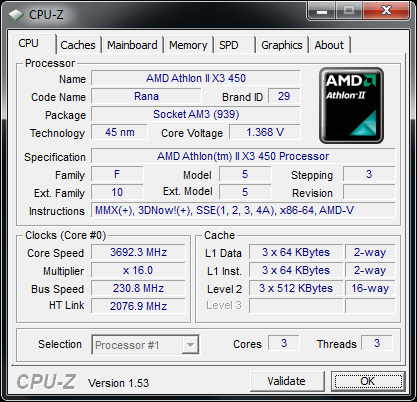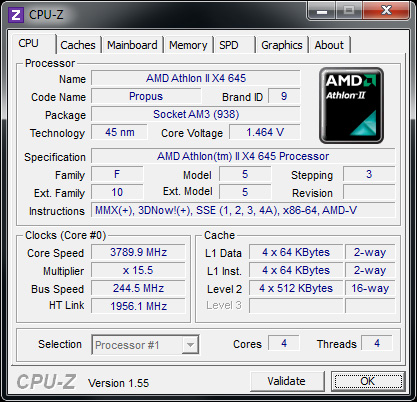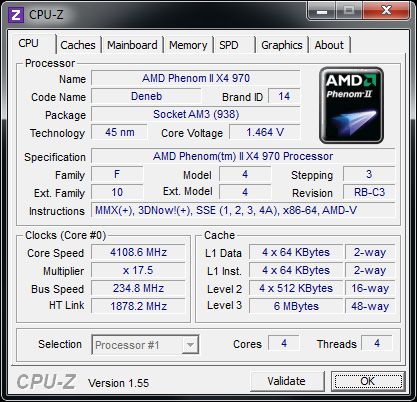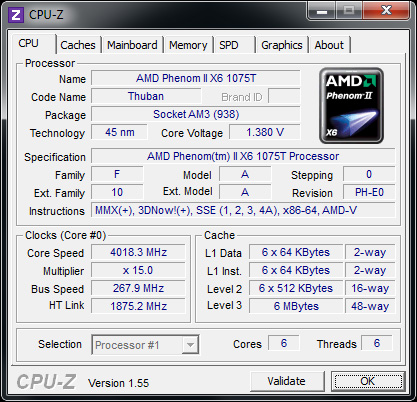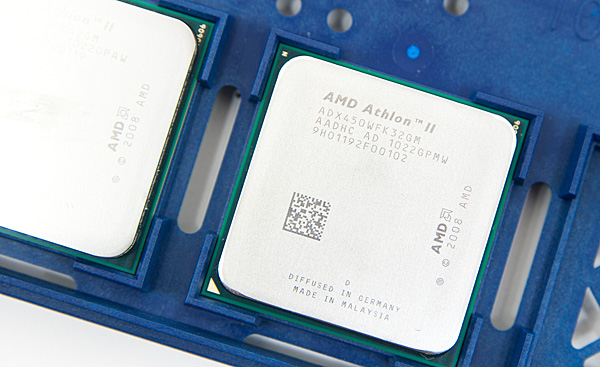
|
TopNax |
|
Home Previous AMD page Intel page Next |
x264 HD Video Encoding PerformanceGraysky's x264 HD test uses x264 to encode a 4Mbps 720p MPEG-2 source. The focus here is on quality rather than speed, thus the benchmark uses a 2-pass encode and reports the average frame rate in each pass.
Video encoding performance is a definite strength of the Phenom II X6. You get comparable performance to the more expensive Core i7 860. And without Hyper Threading, the Core i5s are unable to distance themselves from the Phenom II X4 970. Again the Athlon II X4 645 and X3 450 dominate their respective competitors. PAR2 Multithreaded Archive Recovery PerformancePar2 is an application used for reconstructing downloaded archives. It can generate parity data from a given archive and later use it to recover the archive Chuchusoft took the source code of par2cmdline 0.4 and parallelized it using Intel’s Threading Building Blocks 2.1. The result is a version of par2cmdline that can spawn multiple threads to repair par2 archives. For this test we took a 708MB archive, corrupted nearly 60MB of it, and used the multithreaded par2cmdline to recover it. The scores reported are the repair and recover time in seconds.
The direct comparisons we've been pointing out this entire match continue to hold as we look at different applications. The Phenom II X6 1075T performs as it should, while the Phenom II X4 970 falls short of the i5 750. The triple and quad-core Athlon IIs couldn't be better. 7-Zip Benchmark PerformanceIncluded in 7-zip is a pure algorithm test that completely removes IO from the equation. This test scales with core count and as a result we get a good theoretical picture of how these chips perform. Note that the actual 7-zip compression/decompression process is limited to 2 threads so there's no real world advantage to having more cores.
|
Sonar 8 Audio Mixing PerformanceIn our only digital audio production test we take a multi-track recording and export it to a WAV file using Sonar 8. The benchmark isn't very well threaded and prefers two very fast cores to several slower ones:
As I mentioned before, this is the biggest issue with AMD's lineup. If you're running applications that can't use the extra cores, AMD's advantage typically disappears. Gaming Performance
At the high end, AMD's Phenom II X6 and X4 lose to the similarly priced Lynnfields. In the middle the Athlon II X4 645 and Athlon II X3 450 do very well.
With the exception of the Phenom II X6 and X4 processors, AMD is generally competitive here. Intel maintains the performance advantage above $200. There's an unusual amount of variance in our tests here (particularly old vs. new AMD results). The variance appears to be caused by the platform shift as we moved all of our AMD testing to the same 890GX motherboard. The change in performance under Dawn of War II however doesn't really change the standings.
WoW performance is governed by two threads thus negating any core count advantage. AMD loses at the high end but is competitive around the $100 mark.
Starcraft 2 performance is something we're beginning to look at. Again we have a situation where a game doesn't use more than two cores. The Phenom IIs are slower than Lynnfield, while the multi-core Athlon IIs do well against their competitors. If you're building a fast Starcraft 2 box that doesn't have to do anything else, the dual-core CPUs do better here. |
Power ConsumptionWith no 32nm quad-cores to compete with, AMD actually does very well in the power consumption comparison. Idle power is comparable to Intel, while load power is generally higher for similarly priced AMD parts.
|
OverclockingGlobal Foundries has been hard at work. While most of its public discussion has been about ARM and 28nm, AMD’s foundry partner continues to crank out 45nm SOI parts. Overclocking in general has improved on AMD’s CPUs as GF’s 45nm process is fairly mature. When I reviewed the Athlon II X2 255 in January I indicated a 3.7 - 3.8GHz overclock was within reason. My Athlon II X2 265 sample managed 3.89GHz:
Moving up the totem pole the Athlon II X3 450 topped out at 3.692GHz:
The Athlon II X4 645 managed a 22% overclock to 3.789GHz:
Our best overclock with the stock cooler came from the Phenom II X4 970 at 4.1GHz:
Finally we have the 1075T that managed a 4GHz overclock, although I wasn't convinced of the overclock's stability in my tests - dropping down to 3.9GHz is probably a safer bet in this case:
|
Final WordsRemaining relevant is something AMD has done a good job of with its Athlon II and Phenom II lines. Without a major redesign, AMD has managed to squeeze a reasonable amount of performance out of the Phenom II architecture. Pricing is what makes this all work. By being more aggressive on the pricing front than Intel, AMD is able to actually pull off some unquestionable wins. The Athlon II X4 645 consistently does better than its dual-core competition and if you give up a little bit of clock speed you can even get the CPU down to the $100 mark with the Athlon II X4 640. The same is true for the Athlon II X3 450. At $87 there's simply nothing in Intel's lineup that can come close in most tests.
The dual core offerings are less interesting as you don't save a ton of money and lose the core-count advantage that the X4 and X3 give you. The Phenom II X6 1075T is an interesting chip as you get a lot of compute but it's only useful in heavily threaded apps. While AMD does have its own turbo mode on the 1075T, it's not enough to save the chip in lightly threaded applications. The Phenom II X4 970 can be pretty close to the Core i5 760 however. Intel is faster in gaming and certain applications (e.g. Photoshop), while AMD was competitive in our encoding test and Cinebench. Overall I'd say the new Athlon II X4 and X3 are really the stars of the show. If you're spending ~$100 on a new CPU, AMD makes it. |
|
Home Previous AMD page Intel page Next |
